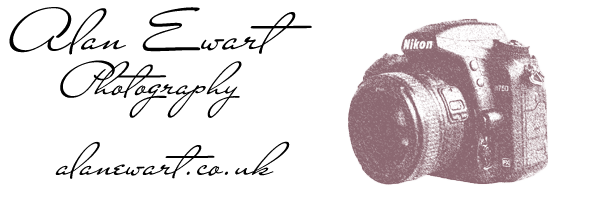In the world of photography the portrait is king! Portraiture is used in virtually every type of photography and it is a type of photography that every photographer should master. But what are the different types of portrait photography? This simple guide will introduce you to 12 different types of portrait photography and provide tips and techniques to help you to experiment and master the art of portraiture.
What do we mean by portrait photography?
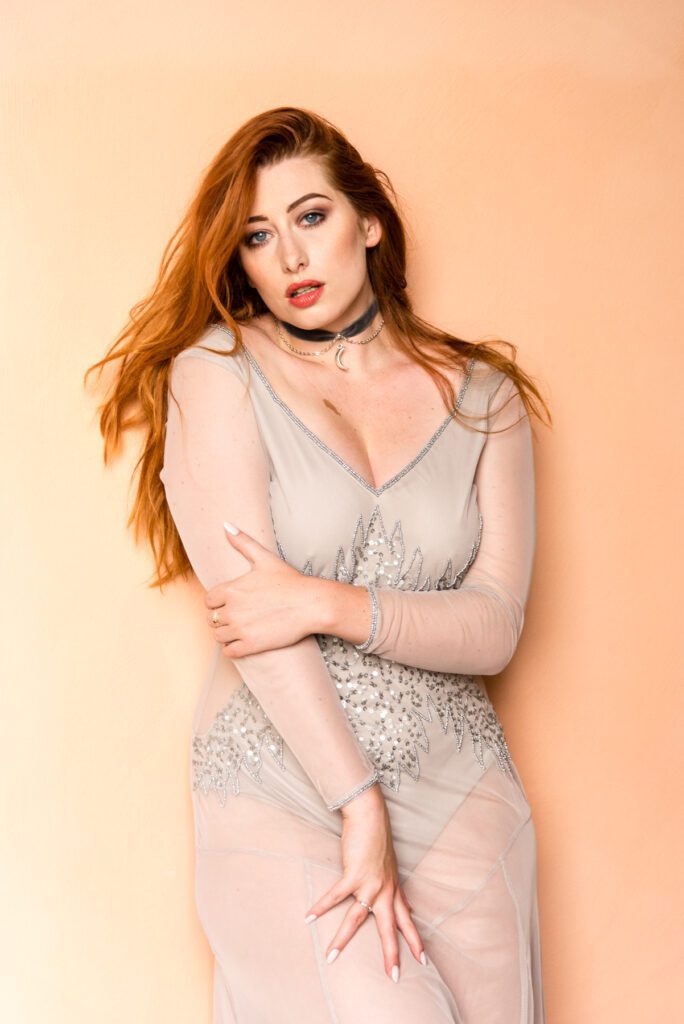
Portrait photography aims to capture the personality of a person, or group of people, or even a pet, using a combination of lighting, pose, and background.
A portrait can be formal, artistic, or clinical but the key element is that the focus is on the subject, in other words, the subject is the reason for the photographs existence.
Portraiture isn’t just taking an image of a person, it is an art form that requires work and experimentation to master. It’s a form of artistic expression and knowing how to best capture your subject is key if you want to achieve high-quality results that capture the personality of the subject.
It is important to understand what the different types of portrait photography are because experimenting with them all will not just improve your photography skills, it will also help you to discover your “photographic voice” and to develop a personal style.
Before we talk about the different types of portrait photography, a word about the equipment that you might want to consider.
Essential Equipment For Portrait Photography
If you have read my previous articles on photography gear, you will know that I am a great advocate for getting started in photography on a tight budget. In this regard getting started in any form of portrait photography is no different, great portraits can be created with gear that costs very little in photography terms.
Any camera body, by any camera maker, manufactured in the last 10-years will allow you to create beautiful portraits. With any type of photography, the choice of lens is much more important than the choice of camera. So what is the best lens for any kind of portrait photography?
It would be fair to say that an 85mm lens on a full-frame camera is widely regarded as the best lens for portrait photography.
The 85mm lens is so good for different types of portrait photography that it is widely known as a “portrait lens” As long as you have sufficient space the 85mm is great for half-length photos as well as closeups.
As the name suggests, an 85mm lens has a fixed focal length, there is no ability to “zoom” in on the subject. You zoom by moving your feet. This type of lens is known as a “prime lens.” If you are not sure what is meant by a prime lens, check out this 2-minute video for a great explanation.

The beauty of the 85mm prime lens is that it has a wide aperture, allowing you to blur out the background in an attractive way. This pushes the viewers focus onto the subject, a key element in successful portrait photography.
Of course, quality comes at a price. I personally use the Sigma 85mm F1.4 Art Lens which weighs in at close to £1000, so it is certainly a serious investment and beyond the budget of many beginner photographers. As a general rule, prime lenses increase in price with the maximum width of aperture.
For example, a Nikon 85mm with a F1.8 aperture can be bought for around £450. Step up to the similar lens with a 1.4 aperture and the price increases almost four-fold to around £1700.
Thankfully there is a much more budget-friendly alternative. The humble 50mm f1.8 lens can be bought for under £200. On a crop sensor camera, the 50mm lens has a focal length equivalent to around 85mm on a full-frame camera.
This little lens is one that every photographer should have in their bag. It’s small, light, and packs a huge punch for its price range. Little wonder that it is frequently referred to as a “plastic fantastic” or the “nifty fifty.”
The main reason for using an 85mm, or equivalent, lens is that the focal length is flattering and doesn’t distort your subject. No one wants a portrait that makes their face look too fat or thin. Obviously, you can avoid portrait distortion using a zoom lens. You can easily use something like a 24 – 105mm or a 70 – 200mm lens and simply set the lens to around the 85mm focal length.
These lenses are a great option if you want a multi-purpose lens, especially if you can afford a lens with a fixed F2.8 aperture across the entire focal range. A 24 – 105mm lens opens up a range of different types of portrait photography without having the restrictions of space for making photos of family groups for example.
Enough about cameras and lenses, what other equipment should you consider?
Additional Equipment for Portraiture
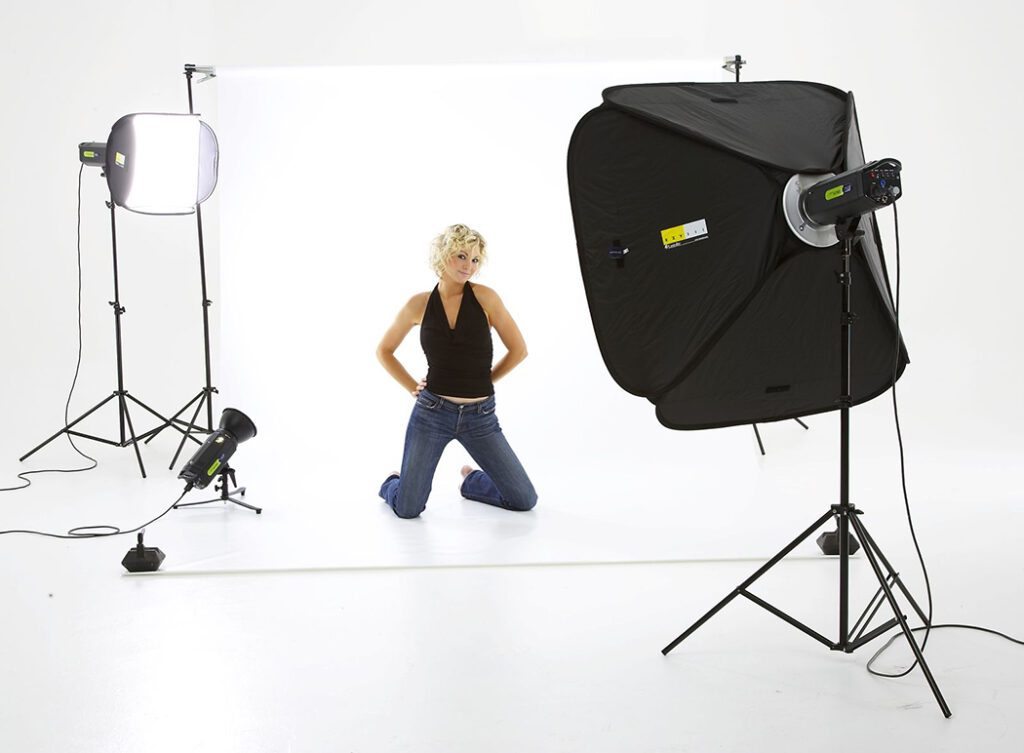
Once you have settled on a camera and lens for your portrait photography the list of additional equipment does not have to be complicated.
You will, of course, need a light source, and a means of controlling that light. In a typical studio portraiture set up, you will need a main light, a background, and a means of triggering the light.
It is entirely possible to create beautiful portraits with a single light and a simple background. The good news is that if you are on a budget you can achieve this very economically.
In an ideal world a studio strobe and a large soft box is the best option. In a previous article I talked about the hierarchy of light, if you don’t know what that means check out the article. For our purposes it is sufficient to understand that the bigger your soft box is the softer and more flattering the light will be.
Flattering light is arguably more important when photographing women as it is less likely to show up flaking makeup or skin imperfections. Of course, there are many occasions where you will want to use soft light with men, or even with products, but that is beyond the scope of this article.
Not everyone can afford expensive studio strobes or quality backgrounds in a range of colours, and not everyone has access to a studio or the space to create one at home. So how can we achieve a similar result on a budget?
The simplest and most budget friendly way to light a portrait is to use a source that is free and virtually unlimited for a large part of every day. Daylight!
As this portrait shows window light can often be beautifully flattering.
Top Tip! – if possible use a north facing window as the light is likely to be soft even in the middle of a bright sunny day.
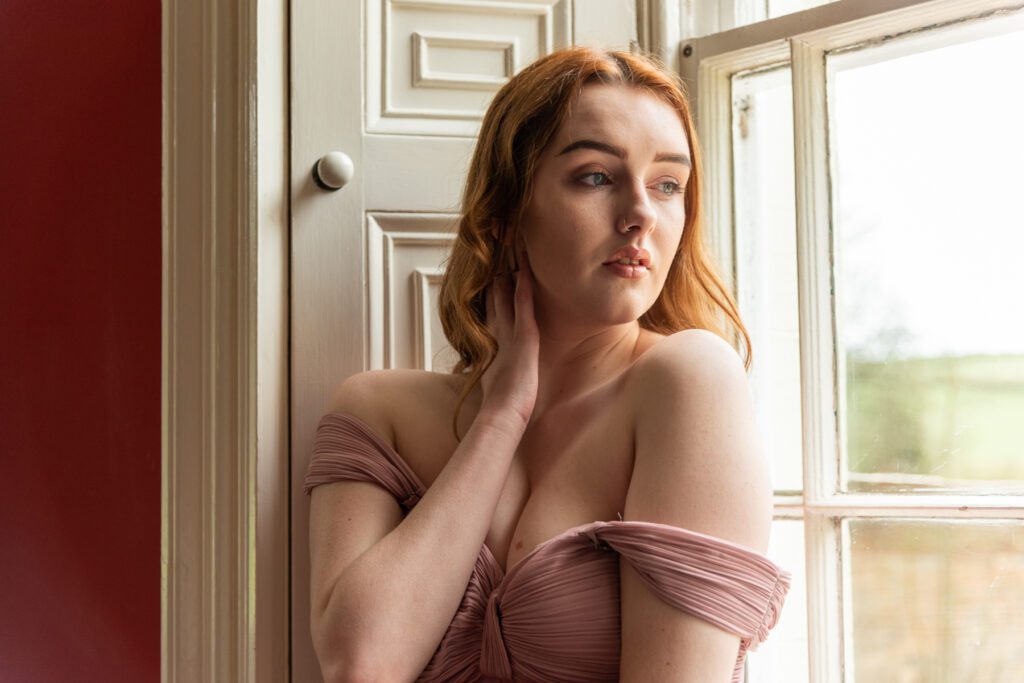
A large reflector is an incredibly useful addition to any photographers kit bag. In a portrait like that above, it can be used to act a soft fill light to brighten the darker side of the image. A decent reflector can be bought for around £20, but if you don’t have one it is easy to improvise.
A large sheet of white card or styrofoam makes a great reflector, you can even adapt it to provide a crisper light by covering it with silver kitchen foil. If you don’t have a suitable background use a white painted wall. Doing so in a corner has the additional benefit of one wall acting as a reflector whilst the other is a background.
Whilst it isn’t absolutely essential, I highly recommend investing in a sturdy tripod for shooting portraits. These can be used in the studio and on location to remove camera shake, thereby ensuring pin sharp images.
Top tip: If your lens has vibration reduction built in, ensure it is switched off if you are using a tripod.
When you rely on daylight to light your portraits you are at the mercy of the sun. On a bright sunny day the light can be incredibly hard, especially in the middle of the day. You can get much better light if you shoot when the sun is low in the sky, particularly around sunrise and sunset, the so called blue and golden hours.
The last item that I recommend for the portrait photographers kit bag is a speed light. Branded speed lights can be very expensive, but there are some really good budget alternatives. I have had a lot of success with Yongnuo speed lights. To be fair these lights have increased in price recently as they have become incredibly feature rich.
You should be able to pick up a pair of these speed lights and a trigger for around £200. A trigger is an essential purchase as you will want to use the lights off camera. You can also buy cheap attachments that will allow you to fit soft boxes to the lights.
If you are not confident using flash I recommend visiting David Hobby’s Strobist website, undoubtably the most comprehensive resource for learning lighting techniques on the internet.
Now that we have had a look at the gear let’s turn to the different types of portrait photography.
What are the different types of portrait photography?
Before I begin I should explain that I totally accept that my definition of the different types of portrait photography is open to interpretation. I have seen people argue that there are only three different types of portrait photography. Others claim that there are seven.
I do not disagree with their interpretation. There is significant crossover between the styles I discuss below and I accept that some of them could be interpreted as a subset of a larger photographic style.
I break the genre of portrait photography into 12 different types because I believe it is helpful to consider as wide a range as possible if we are to really understand what makes a great portrait.
When you are making photographs it pays to remember a couple of quotes from British photographer Bill Brandt who reminds us:
Photography is not a sport. It has no rules.
Photographers should follow their own judgment, and not the fads and dictates of others.Bill Brandt Tweet
What this means to me is this: the most important style of portrait photography is your own. All I hope to achieve by outlining 12 different types of portrait photography is to give you things to think about.
I hope to inspire you to try shooting portraits in different ways, by doing so I hope you will discover your own personal style because, above all, a portrait should connect with you on a personal and emotional level.
So having said all of that let’s have a look at my 12 different types of portrait photography.
Traditional Portrait Photography

Traditional portrait photography is probably the style of portrait that most of recognise as a portrait.
This style is typically studio based and feature nothing more than the subject against a plain or patterned background.
The subject is typically posed in flattering light and the photograph is usually either just head and shoulders or, as in this case, half length.
This style of portrait remains very popular as they are flattering and there is little to distract the viewers eye from the subject.
The traditional portrait is usually quite formal with the subject dressed to impress. This is the portrait style photo that the subjects mum loves to hang on their wall.
This is arguably one of the easiest portrait styles to master as it can be achieved with a suitable background and a very simple lighting set up. A single light with a softbox or a beauty dish is all that is required to produce a beautifully flattering photograph.
Candid Portrait Photography
Candid portraits tend to be more casual. The subject may not even know that they are being photographed.
Candid photographs are not posed and are usually unplanned. This means that the photographer has to be well prepared and that they usually have to work with whatever light is available.

This means that the photographer either has to preselect the camera settings and be ready to adjust really quickly. If you need to fiddle with your camera settings the moment will be lost.
Where possible the candid portrait should feature one person, and it should be obvious who the subject is. Of course, as is the case in the image above, it can be impossible to avoid other people in the background. Nonetheless, the subject is obvious, and the image gives a more genuine insight into the subjects emotions at the time the candid image is captured.
Candid photography lends itself to the sort of “snapshot” aesthetic I employed during my “Regarding Family” project.
The candid portrait bears a strong relationship to the next portrait style we will consider, the lifestyle portrait.
Lifestyle Portrait Photography
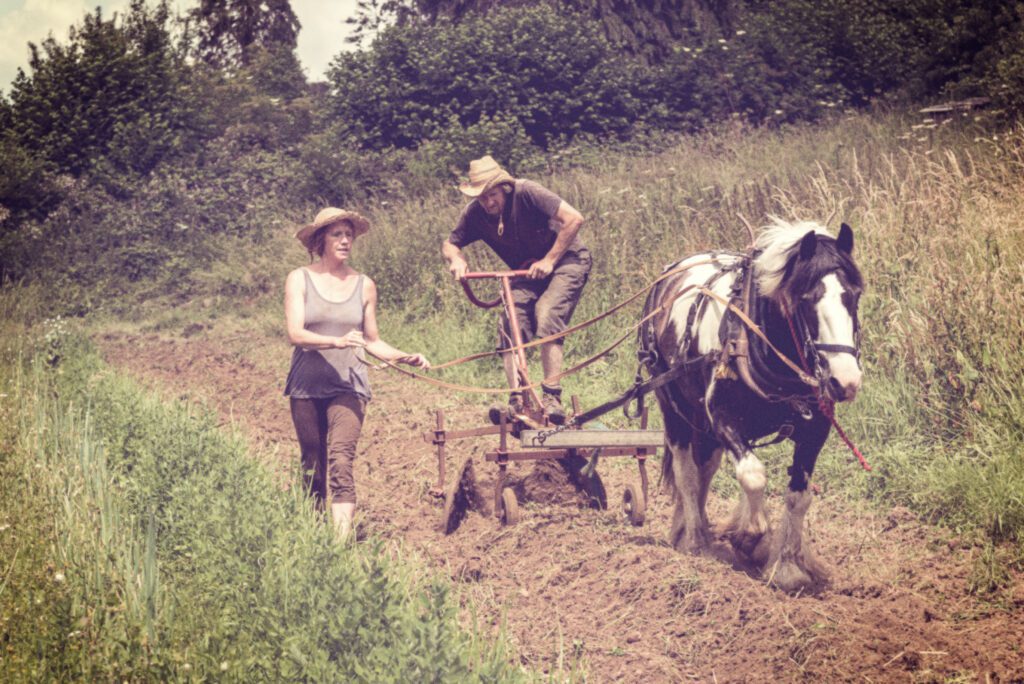
Lifestyle portraits are almost the opposite of traditional portrait photography. Like candid portraits, lifestyle portraits are usually captured in an everyday location like a home or a coffee shop.
The lifestyle portrait is much loved by advertisers as they often reflect an aspirational lifestyle or a product. Unlike candid portraits, the lifestyle photograph is often posed in a way that makes it appear to be unposed.
The subject will certainly know that they are being photographed, and they are likely to be directed into poses by the photographer or art director. They will typically be posed in a way that makes it appear that they are having fun with a product.
There is a form of lifestyle photography that reflects reality rather than being about advertising a product. For example in the image above the subjects live in an alternative lifestyle community, They are self-sufficient and farm their own produce using traditional methods.
In some senses, lifestyle portraits are similar environmental portraits.
Environmental Portrait Photography
In the environmental portrait the subject(s) and the environment share equal importance. For example, in this image my client wanted portraits for her website that reflected the area where she conducts her business.
We chose an area that she frequently visits to walk her dog and that is recognisable to many of her clients. The environmental portrait gives an insight into the subjects personality.
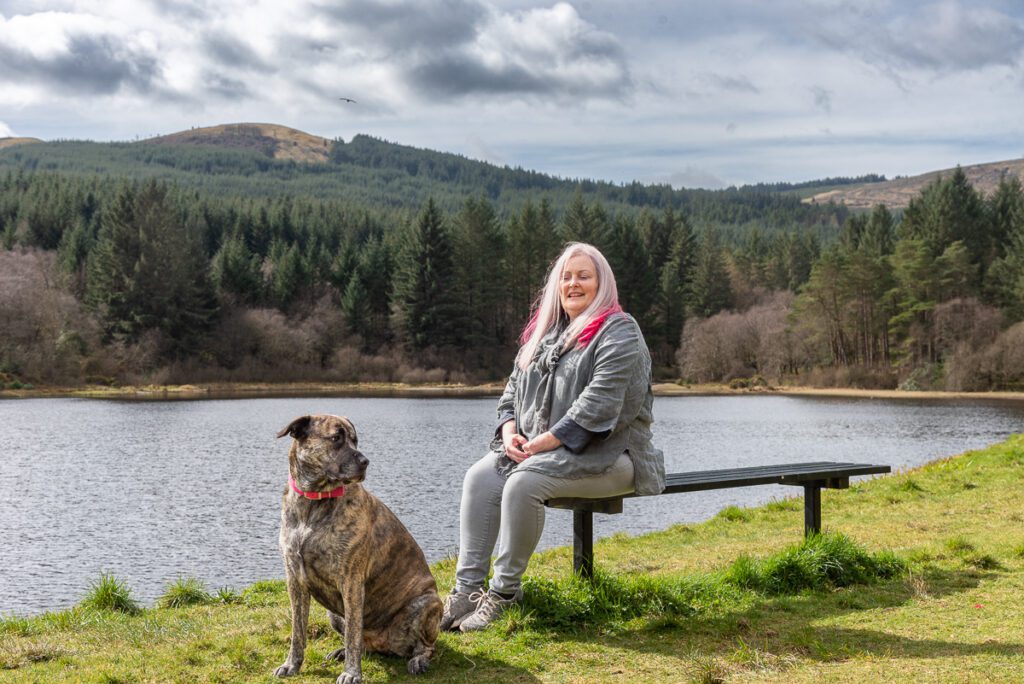
Environmental portraits are posed and the subject is aware that they are being photographed. The photograph tens to be more planned and formal than a lifestyle portrait. The location is important and could as easily be taken in an office or the clients home.
Conceptual Portrait Photography
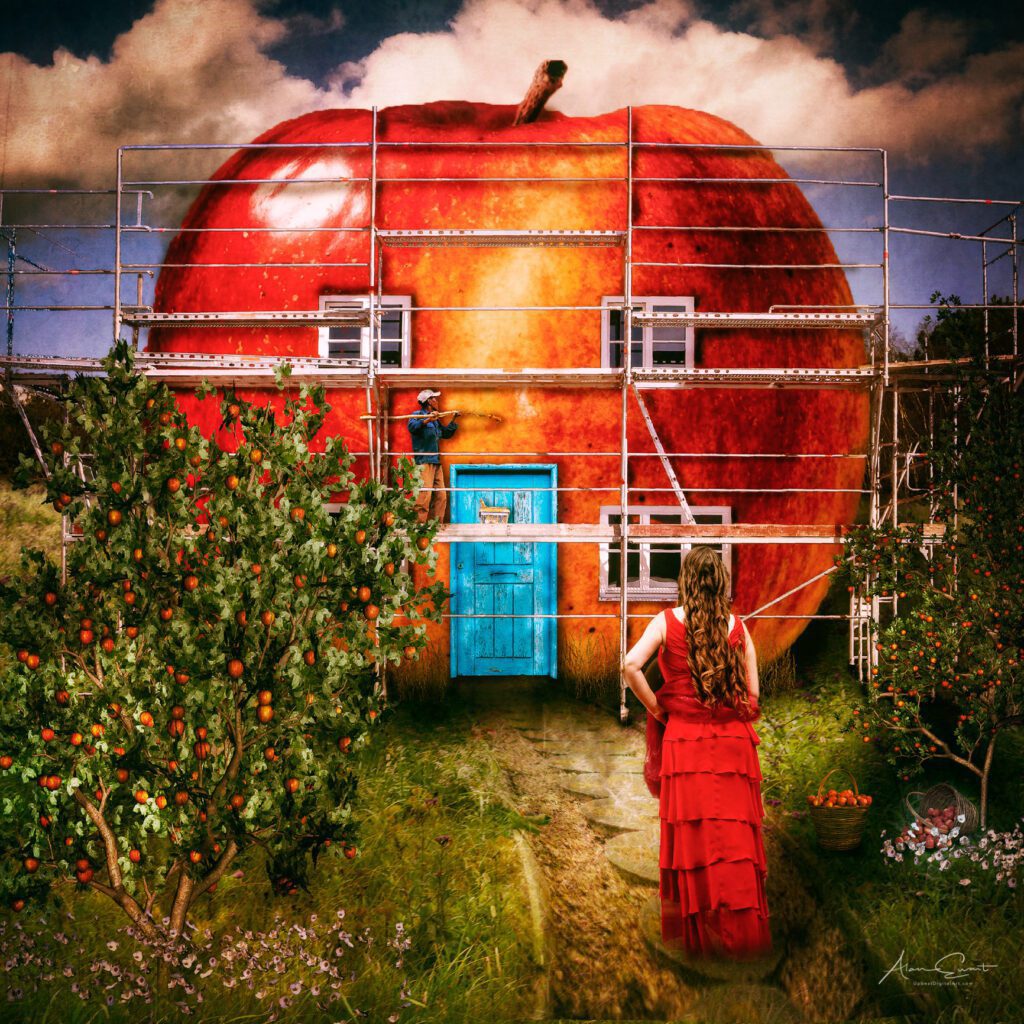
Conceptual portraits capture an idea and the photographer must plan every aspect of the shoot to execute the idea and bring it to life.
The possibilities of this photographic style are limited only by your imagination. The end result is often a fantasy art image.
Typically, the photographer will use props, styling, and a lot of time in photoshop to create the end result.
Conceptual portrait photography shares many characteristics with the next of our different types of portrait photography, the surreal portrait.
Surreal Portraits
Surreal photography is all about creating an image that cannot exist in reality. As a result these images require some trick photography and considerable work in photoshop or a similar application.
For this image I mounted the camera on a tripod to ensure that the background remained consistent. My son then threw a ball into the cameras field of view so that my little Fox Red Labrador puppy would jump for it.
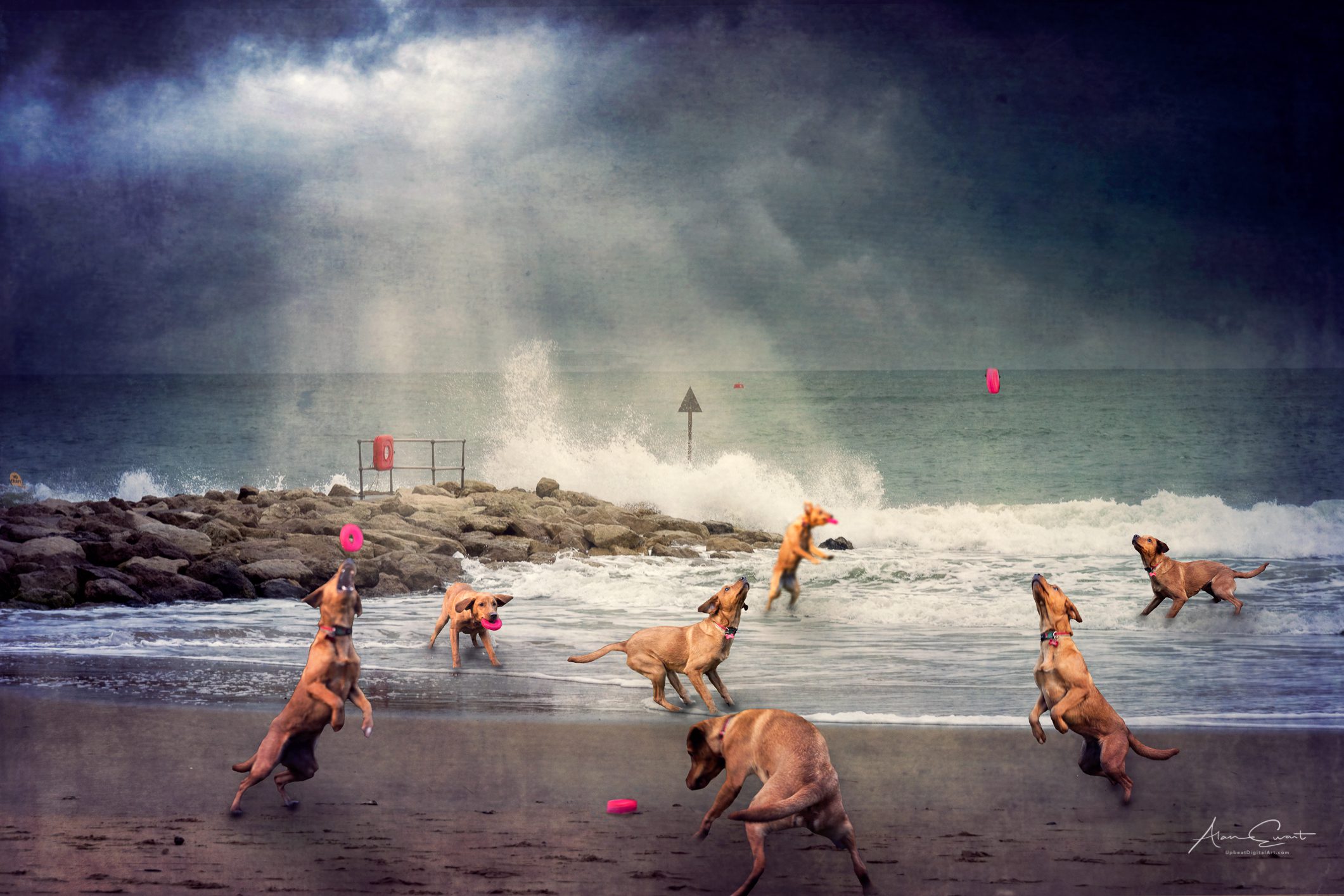
All of the captured images are then stacked as layers in photoshop and have a black layer mask added. Using a white brush on the layer masks allowed me to reveal the puppy at various locations to create the final image.
The addition of textures and pained light gives the image a painterly feel. The results are always fun. This is a great way to create fantasy images that are totally unique, you are only constrained by your imagination.
Fine art portrait photography
However, most will agree that “fine art” photography is about context, concept, styling, and storytelling. The images in the carousel above represent fine art portrait photography to me, largely because they contain all of the elements mentioned above.
Perhaps you disagree, if so drop me a message and explain why. I guess that the ultimate arbiter of “fine art” is your personal view, is this something you can see hanging on a wall? If it is, then I think it is fine art.
Self portraits
Instagram feeds full of outing “selfies” gives the concept of self portraits a bad name. However, done well self portraits can be the ultimate form of personal expression for a photographer.
Self portraits require planning, insight and self awareness. They also require a great deal of self confidence and the willingness to bare your soul to the world (or at least to your viewer.)
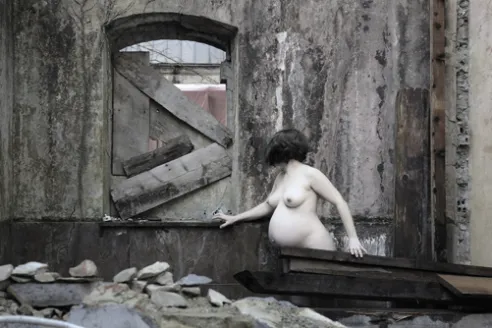
Typically the camera will be mounted on a tripod and triggered remotely. Admittedly the advent of the smartphone has made self portraiture a little easier. Many cameras can be triggered by an app on your phone and you will be able to see what the image looks like before triggering the shutter.
As can be seen in the image above by French photographer Marie Bienaimé self portraits can make an incredibly strong statement.
Glamour portrait photography
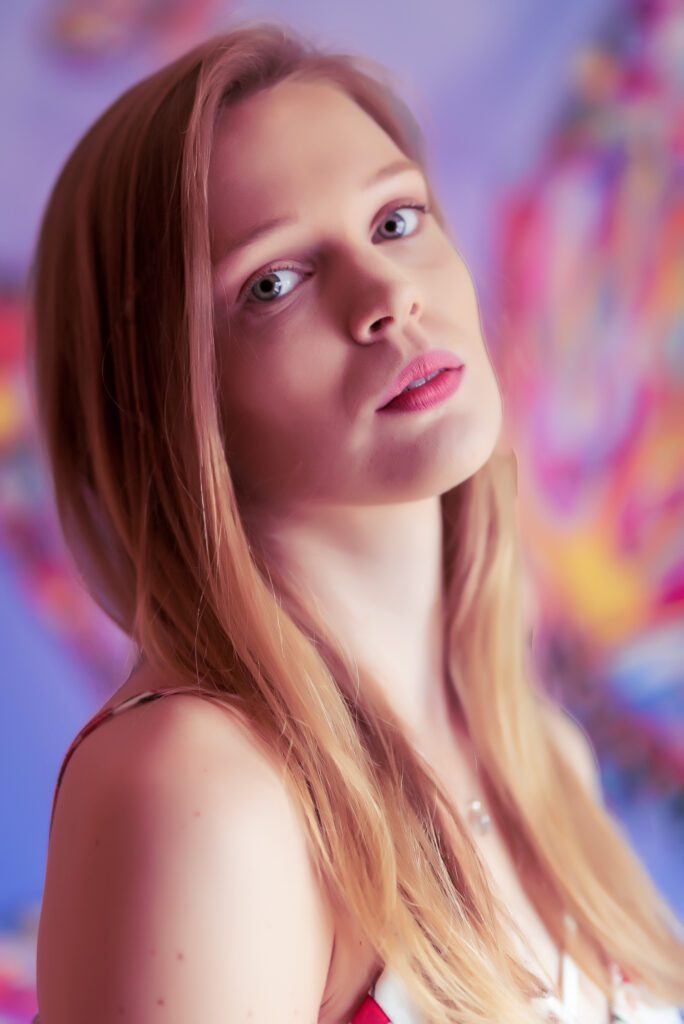
Glamour photography often gets a bad rap because many people equate it with top shelf “lads” magazines.
I prefer to think of glamour photography as beauty photography. Makeup, hair, styling, and lighting combine to give the subject a glamorous appearance.
Glamour photography can be sensual and often depicts women nude or in lingerie.
Glamour photography can be similar to fashion photography except that the emphasis is on feminine beauty rather than on the clothing.
Glamour portraits are similar in many respects to a different type of portrait photography, the boudoir image. Where a glamour portrait can be taken anywhere the boudoir portrait, as the name implies is usually taken in the home, typically in the bedroom.
Boudoir Portraits
Like the glamour portrait, the boudoir photograph typically emphasises feminine beauty and sensuality.
The boudoir portrait doesn’t have to be all about lingerie, titillation, and sexual poses. I prefer to think that the images are about confidence and female empowerment.
The overall feedback I have had from women after boudoir shoots like this one is that they gain a huge amount of confidence.
Boudoir photo sessions are often undertaken when the subject wants to create a special gift for a partner.

Street portraits
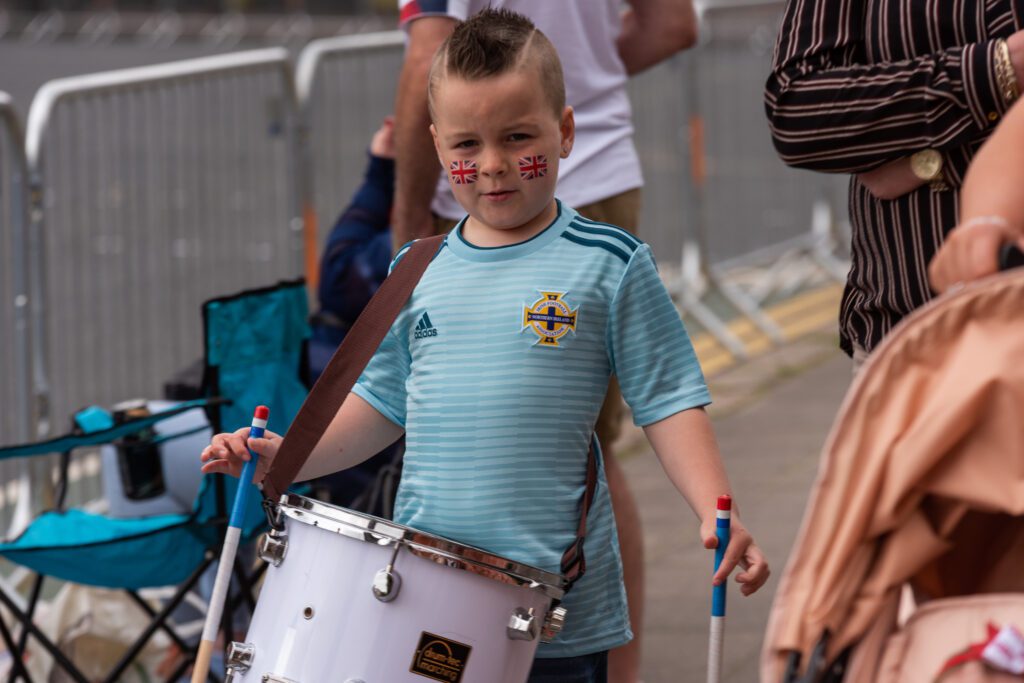
Of all the different types of portrait photography available, it is perhaps street photography that creates the most controversy.
Street photography by its very nature tends to be candid in nature. That is the subject is not posed and may not be aware that they are being photographed.
In recent years the issue of privacy and the right to be forgotten has come to the fore. This has led to conflict when photographers are taking street portrait shots. This is especially important if you are going to photograph children. Parents are rarely happy to see a photographer with a long lens photographing their kids.
My advice is always to ask your potential subject for permission and to ensure that parents are happy if you want to photograph a child. Of course, this does mean that the sense of spontaneity that defines good street photography is often lost, but street portrait shots are still worthwhile.
It can be difficult to approach a stranger and ask to take their photograph. I recommend handing them a business card and offering them a free copy of the photograph.
In the UK you are legally entitled to photograph anything and anyone in a public place, but I would argue that acting in an open and ethical way is much less likely to earn you a punch on the nose than exercising your rights indiscriminately.
If you are refused permission, accept the decision with good grace and a friendly smile and move on.
And so we come to the last of our 12 different types of portrait photography, group portraits or family photography.
Group Portraits and Family Photography
As a professional photographer who has portraiture as one of his specialities there is one thing I constantly hear from other, mostly amateur, photographers.
That is “photographing families is really boring.” When I hear this comment, I just shrug and smile. One of my favourite portrait photography tips is that you should try to make every photoshoot fun for everyone involved, and that includes you, the photographer.
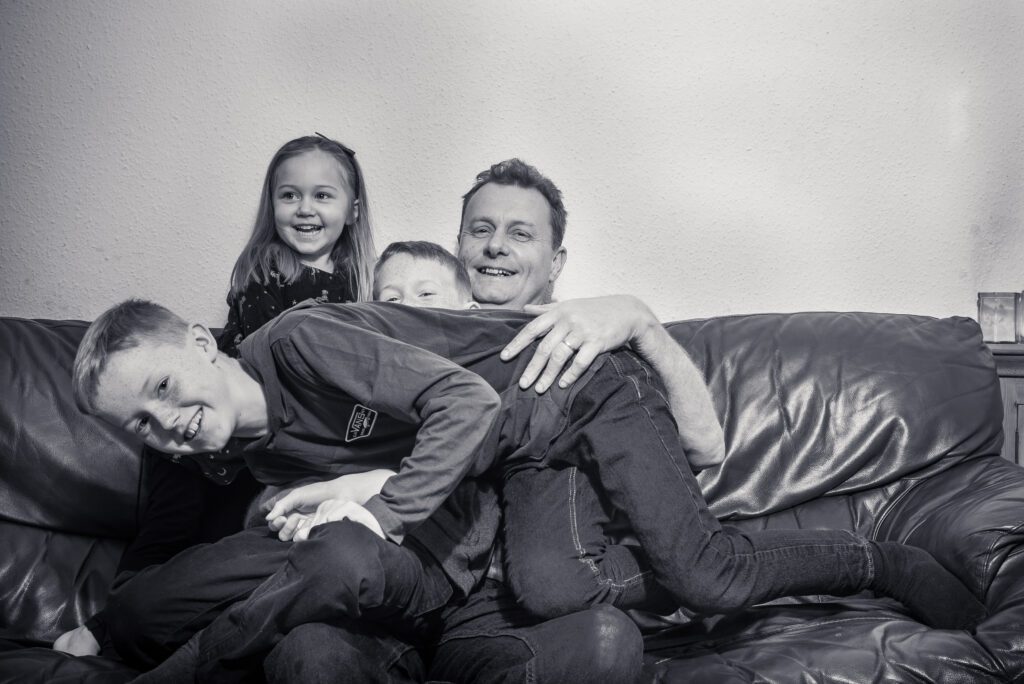
Be realistic, if you are bored with any kind of photography stop doing it. If you don’t enjoy the shoot, you won’t do your best work. If your work is substandard you certainly won’t get repeat business, and you probably won’t get business from the family’s friends and relatives.
If you make the shoot fun for everyone your group or family will be more relaxed and comfortable and that means you will create images that the family will truly value. Believe me, there is no better advertisement than word-of-mouth recommendations from a very happy client.
Conclusions
In this article we have looked at what portrait photography is and discussed 12 different types of portrait photography. We have discussed portrait photography techniques and tips and even the portrait photographers kit bag.
I hope that the article will inspire you to experiment with different types of portraits and to expand your own photographic styles.
As a footnote, you may have noticed that I have not mentioned wedding photography or documentary portraits. That is simply because I believe that wedding photography simply encompasses many of the portrait styles already mentioned.
Documentary photography is one of my specialist areas and will be subject of an in-depth article in due course.
If you have enjoyed this lengthy article and wish to be kept informed about future updates please subscribe to my mailing list via the link at the bottom of the page. I promise that I won’t spam your inbox. If you have any comments or questions please feel free to email me. I will do my best to answer your questions.
